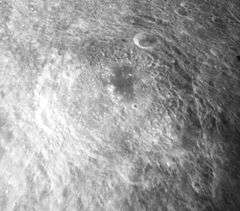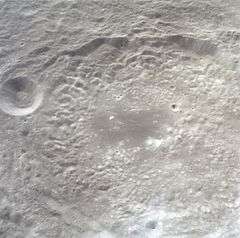Langemak (crater)
|
Lunar Orbiter 1 image | |
| Coordinates | 10°18′S 118°42′E / 10.3°S 118.7°ECoordinates: 10°18′S 118°42′E / 10.3°S 118.7°E |
|---|---|
| Diameter | 97 km |
| Depth | Unknown |
| Colongitude | 242° at sunrise |
| Eponym | Georgy E. Langemak |


Langemak is a prominent impact crater on the far side of the Moon. It is located less than one crater diameter west-northwest of Danjon, and nearly due east of Meitner. To the southwest of Langemak is Kondratyuk. Langemak partly overlies the larger and older crater Langemak N. This feature is also attached to the northeastern rim of Kondratyuk.
To the northeast of Langemak is the crater Necho, an impact feature that lies at the locus of a bright ray system. Ray material from this impact lies across the rim and interior of Langemak, particularly along the northwest and eastern halves.
The outer rim of Langemak is relatively fresh and well-defined. The most notable impact along the rim is the small crater Sherrington along the southwestern edge. The remainder of the rim is roughly circular, but irregular with multiple small outward bulges. The inner wall is terraced in places, with the appearance of slumping along parts of the upper edge.
Within the interior is a low, curving central ridge near the midpoint. There is a patch of lower albedo material to the southwest of this ridge, extending to the edge of the inner wall.
Satellite craters
By convention these features are identified on lunar maps by placing the letter on the side of the crater midpoint that is closest to Langemak.
| Langemak | Latitude | Longitude | Diameter |
|---|---|---|---|
| N | 12.9° S | 119.0° E | 126 km |
| X | 6.6° S | 117.5° E | 47 km |
| Z | 5.6° S | 119.3° E | 27 km |
References
- Andersson, L. E.; Whitaker, E. A. (1982). NASA Catalogue of Lunar Nomenclature. NASA RP-1097.
- Blue, Jennifer (July 25, 2007). "Gazetteer of Planetary Nomenclature". USGS. Retrieved 2007-08-05.
- Bussey, B.; Spudis, P. (2004). The Clementine Atlas of the Moon. New York: Cambridge University Press. ISBN 978-0-521-81528-4.
- Cocks, Elijah E.; Cocks, Josiah C. (1995). Who's Who on the Moon: A Biographical Dictionary of Lunar Nomenclature. Tudor Publishers. ISBN 978-0-936389-27-1.
- McDowell, Jonathan (July 15, 2007). "Lunar Nomenclature". Jonathan's Space Report. Retrieved 2007-10-24.
- Menzel, D. H.; Minnaert, M.; Levin, B.; Dollfus, A.; Bell, B. (1971). "Report on Lunar Nomenclature by the Working Group of Commission 17 of the IAU". Space Science Reviews. 12 (2): 136–186. Bibcode:1971SSRv...12..136M. doi:10.1007/BF00171763.
- Moore, Patrick (2001). On the Moon. Sterling Publishing Co. ISBN 978-0-304-35469-6.
- Price, Fred W. (1988). The Moon Observer's Handbook. Cambridge University Press. ISBN 978-0-521-33500-3.
- Rükl, Antonín (1990). Atlas of the Moon. Kalmbach Books. ISBN 978-0-913135-17-4.
- Webb, Rev. T. W. (1962). Celestial Objects for Common Telescopes (6th revised ed.). Dover. ISBN 978-0-486-20917-3.
- Whitaker, Ewen A. (1999). Mapping and Naming the Moon. Cambridge University Press. ISBN 978-0-521-62248-6.
- Wlasuk, Peter T. (2000). Observing the Moon. Springer. ISBN 978-1-85233-193-1.
